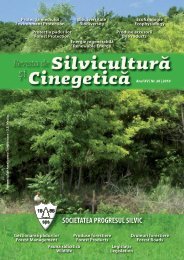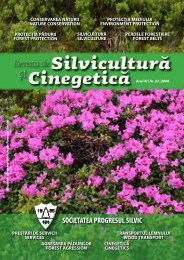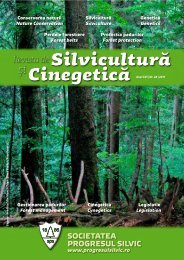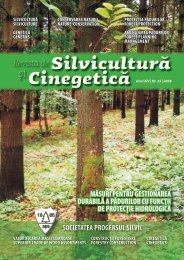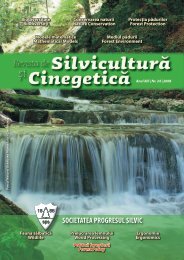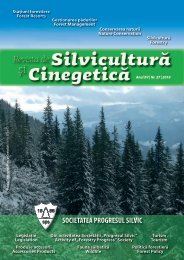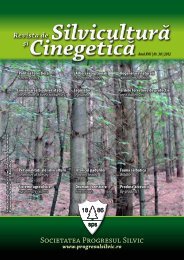Silviculture and Cinegetics Review - Societatea Progresul Silvic
Silviculture and Cinegetics Review - Societatea Progresul Silvic
Silviculture and Cinegetics Review - Societatea Progresul Silvic
You also want an ePaper? Increase the reach of your titles
YUMPU automatically turns print PDFs into web optimized ePapers that Google loves.
FORESTRY BELTS SILVICULTURE AND CINEGETICS REVIEW XVII/30/2012<br />
They supplement the normal feed obtained in natural pastures in quality (protein content), but for a longer period as well<br />
through seeds <strong>and</strong> dry biomass. In the second case, barley, oats, with a hay drying rate of 3:1, is usually the common solution.<br />
Lolium multiflorum <strong>and</strong> winter cereals are also an option.<br />
Hay is used as feed in summer <strong>and</strong> winter.<br />
Production<br />
Management<br />
Cereals production : wheat ( 1-3 tone/ha), straw ( 2-5 t/ha)<br />
Sown pastures: legume pastures : approx. 3 t / ha dry matter (DM)<br />
Mash: 3-6 t /ha DM as hay.<br />
Two or three tillage before sowing (late winter, early spring, early autumn). Sowing early autumn<br />
Fertilization:<br />
For cereals: N-P-K usually 200-300 kg/ha ( 8-28-8 or 15-151-15)<br />
Pastures rich in legumes: P ( at least 35-40 hg P 2 O 5 /ha before grazing)<br />
Mash : N-P-K usually 200-300 kg/ha with 8-24-8<br />
Permanent pastures rich in legumes have to be sown only when the semi natural pastures show a low density of legumes. In<br />
any other case, phosphorus fertilization is a better option.<br />
2.5. Characteristics of animals<br />
2.5.1. Domestic livestock<br />
Extensive growth of animals is one of the most<br />
important goals of dehesa, at the same time being an<br />
important role in the creation <strong>and</strong> improvement of<br />
natural pastures, in the seed dispersal <strong>and</strong> fertilization.<br />
Table 8. Characteristics of livestock in dehesa (by Olea <strong>and</strong> San Miguel, 2006)<br />
Role<br />
Most important product on the market – animal products<br />
Species<br />
Different species, but mostly breeds of cattle, sheep, pigs <strong>and</strong> horses<br />
Optimum load<br />
Management<br />
2.5.2. Wild animals<br />
Therefore, sustainable management of animal herds is<br />
an essential factor for dehesa <strong>and</strong> biodiversity<br />
conservation. This type of management should be<br />
consistent with silvotechnical measures <strong>and</strong> st<strong>and</strong><br />
regeneration, as sprouts are affected by animal grazing<br />
(in general up to a 12-15 cm diameter or up to 20-40<br />
years old, they being affected by grazing, especially if<br />
animals are fed concentrate including urea) Table 8.<br />
Cattle: 0.2-0.4 /ha<br />
Sheep : 2-4/ha<br />
Goats : 2-3/ha<br />
Pigs : 0.4-0.6/ha<br />
Traditional management is with only a few species, each optimally exploiting a certain category of natural<br />
resources.<br />
A certain distribution of animals is done to reduce damages on the st<strong>and</strong>, to increase grazing efficiency <strong>and</strong> to<br />
reduce parasites <strong>and</strong> pathogens pressure.<br />
Periods of increased food needs of livestock (prolonged gestation <strong>and</strong> lactation) must coincide with the periods<br />
when the amount of feed offered naturally by the dehesa in maximum.<br />
Cattle: The period from November to March. Lactation: 5-6 months<br />
Goats, sheep: two periods. One, period with lambs / year: spring or autumn (<strong>and</strong> the best prices). Three lambs<br />
/season/2 years. Lactation: 45 days<br />
Iberian pig: 2 births/season/year: spring <strong>and</strong> autumn. Fall born piglets are fed to satiety one year (until they reach<br />
90-110 kg) <strong>and</strong> then fed acorn <strong>and</strong> grass from October to January, thus gaining 0.7 kg/day ( until they reach 140-<br />
160 kg , live weight )<br />
Valuable hunting species were always present in the<br />
dehesa ecosystem, but at low density (except for hare),<br />
being considered only a complementary source of food.<br />
In the 60s the situation changed dramatically because of<br />
hunting which became a significant economic activity,<br />
at presents being the most important one in many<br />
dehesa. Wild ungulates, especially deer (Cervus elaphus<br />
hispanicus) <strong>and</strong> wild boar (Sus scrofa) are now seen as<br />
exp<strong>and</strong>ing renewable resources, because of them<br />
l<strong>and</strong>owners often put up fences.<br />
79



